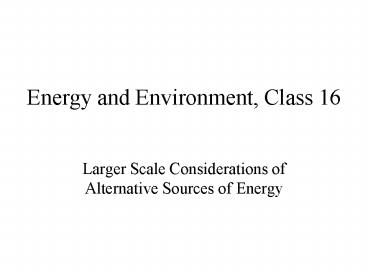Energy and Environment, Class 16 - PowerPoint PPT Presentation
1 / 11
Title:
Energy and Environment, Class 16
Description:
Solar Power: In Prescott, a 10 acre facility produces a peak power of 1 MW. ... 80 square miles was used for solar power, it would produce about 1680 MW, on average. ... – PowerPoint PPT presentation
Number of Views:57
Avg rating:3.0/5.0
Title: Energy and Environment, Class 16
1
Energy and Environment, Class 16
- Larger Scale Considerations of Alternative
Sources of Energy
2
Land Use
- Hydropower
- Lake Powell produces 1250 MW continuously
- Surface area is 254 square miles
- Annually, this is about 44 GWh per square mile of
disrupted land surface - Solar Power
- In Prescott, a 10 acre facility produces a peak
power of 1 MW. - From the solar power calculator
(http//rredc.nrel.gov/solar/codes_algs/PVWATTS/),
a 1 MW solar array (single axis tracking) will
produce 2830 MWh in a year. - This equates to about 184 GWh per square mile
3
Land Use, Cont.
- Wind Power
- In the San Gorgonio wind fields in 1999, the
energy production was 638,445,122 kWh
(http//www.energy.ca.gov/wind/documents/1996-1999
_wprs_report/1996-1999_report_excel_files/Page-27.
xls). The total area of the field is 5487 acres
(http//www.ca.blm.gov/palmsprings/windenergy.html
) - This equates to 74 GWh per square mile.
- Fossil Fuels
- At Black Mesa, about 80 square miles of land is
being strip mined or disrupted during the life of
the mine to produce about 3800 MW continuously. - This equates to 420 GWh per square mile over the
life of the mine - Looking at it another way, if that entire 80
square miles was used for solar power, it would
produce about 1680 MW, on average.
4
Land Use, Cont.
- Biomass
- Corn cultivation uses about 1 acre to produce
about 15 tons in a year. - A ton of biomass produces about 4400 kWh of heat
energy. - If we produce electricity at an efficiency of
35, that means that each square mile would
produce 17.5 GWh.
5
Land Use Summary
- Land Area Comparisons
- Prescott National Forest 1933 sq. mi.
- 1002 area of Arctic Refuge 2340 sq. mi.
- Massachusetts 7838 sq. mi.
- Arizona 113642 sq. mi.
6
Intermittent Power
- Even in the best circumstances, wind and solar
are intermittent and somewhat unpredictable. - In the San Gorgonio pass area, the windmills
typically operate for 6 to 8 hours per day. - For a power grid that is required to operate
24/7, this is a problem. - In Europe, countries like Denmark are
aggressively pursuing renewables for electricity,
with a target (in Denmark) of about 20 of
electricity from wind by 2010. - If a country was to rely on intermittent
renewables for much more than 20 of its
electricity needs, it becomes problematic without
some form of energy storage.
7
Energy Storage
- Batteries
- Used on small scale
- Expensive, need to be replace often,
environmental costs - Pumped water storage
- A different twist on hydropower
- Just as much land surface disruption as
hydropower - Expensive infrastructure
- Flywheels
- Using magnetically suspended wheels with very
little friction, a spinning wheel can store
energy for quite a while. - Current systems are 10 to 250 kW in size
8
Energy Storage, Cont.
- Compressed Air Energy Storage
- Air is pumped into caves or mines and compressed
to 1000 pounds per square inch. - When power is needed, the air is released and the
pressure is used to run a turbine - In practice, natural gas is used to heat the gas
increase the pressure before it gets to the
turbine - A plant in Ohio is designed to produce 2700 MW of
peak power.
9
Compressed Air Energy Storage
10
Hydrogen
- Demonstration of small electrolysis unit and fuel
cell - Electricity can be used to split water into
hydrogen and oxygen in the process of
electrolysis - 2H2O energy gt 2H2 O2
- This hydrogen can be stored and later used as a
fuel - It can be burned at high efficiency
- It can also be used to run a fuel cell that
produces electricity in the reverse process of
electrolysis.
11
Hydrogen, Cont.
- Downsides of hydrogen
- Lower energy density requires more storage volume
compared to gasoline - Ignites at a very low concentration, so leaks
could be dangerous - A recent report (T. K. Tromp Et Al, Science, June
13, 2003) analyzed the possible impact of a leak
rate of 10 to 20 would have on the environment - Their modeling suggest that this could
significantly deplete stratospheric ozone - Very controversial
- (e.g. http//www.rmi.org/images/other/E03-07_SciFu
tureH2Econ.pdf)































